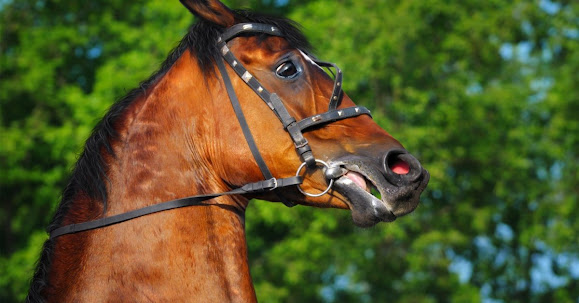Horse Behaviors
When it comes to horse ownership, you need to know all the basic signs of different horse behaviors that you will encounter. Without being able to pick up on horses' body language, it can not just be dangerous, however, but can cause your horse to not trust you and/or obey you. You will have a much better relationship with your horse if you can easily pick up on their attitude, body language, and although it sounds crazy, their facial expressions! That's right, you heard me, their "facial expressions;" Believe it or not, horses are very expressive, especially in their face! Here are all the signs to look for in different horse behaviors:
#1. A content/satisfied/relaxed horse. Head held steady, neither high nor low, just in the middle. Ears will be neutral, eyes open, unfocused. Legs/feet, casual, one foot may be cocked. (Cocked meaning not straight, held up a little bit and leaning in.) Tail will be relaxed with some casual movement. Overall stance, relaxed but engaged.
#2. A bored/at rest horse. The horse's head will be down, ears will be held at "half mast." Eyes will be droopy and staring into the distance, or even closed. Muzzle will be slack, legs/feet inactive, disengaged. May sometimes yawn. Tail, low, still. Overall stance, slack.
#3. An angry/annoyed horse. The horse's neck will be out-stretched, and "snaky." His ears will be pinned back. His eyes will be closed to slits. Muzzle (mouth) will be pursed, legs/feet stomping, striking or kicking. Tail will be swishing. (If you are standing at the rear/or hind leg of an angry horse when his tail is swishing, if long enough, his tail will come around and whip you! Trust me, it hurts!)
#4. A tense/uncertain horse. The horse's head will be held up, neck will be tense. Ears flicking rapidly back and forth. Eyes darting, focus unfixed. Nostrils quivering. Legs/feet may be frozen in place or moving around gingerly. Overall stance, tense, alert and possibly sweating.
#5. Challenging/dominant. The horse's head and neck held high and out, may move slowly back and forth. Ears will be extremely active, eyes will be focused, nostrils flared, active. Muzzle will be active: Lipping, chewing. Legs/feet prancing. Tail held high, swishing. Overall stance, tense, collected.
#6. Curious. The horse's head and neck will be extended toward object or curiosity. Ears intently pricked forward. Eyes intently focused. Nostrils sniffing, blowing. Muzzle pursed. Legs/feet squarely planted. Tail will be held up. Overall stance, moving stiffly.
#8. Fearful. The horse's head will be turned toward source of fear, neck pulled in. Ears will be fixed on source or flicking if source has not been identified. Eyes wide open with whites showing, fixed on source. Nostrils alternately flared and snorting. Legs/feet stand frozen or horse will flee. Tail clamped. Overall stance, crouches, backs up or wheels away and presents hind end defensively.
#9. Submissive. The horse's head will be held low and averted. Ears will be held at "half mast." Eyes averted. Muzzle low, clamped, with lip smacking or chewing in foals and yearlings. Overall stance, placid.
Fun fact! Do you know why horses pin their ears when they are angry? Here's why! Because in the wild, when two horses are fighting, they pin their ears back to prevent the other horse from biting his ear/s off! And obviously, in a fight, they are angry. So that's why horses pin their ears when they are angry! Observe the image below:
If your horse is suspected with a health issue, consult your vet straight away.
google.com, pub-8232596071931364, DIRECT, f08c47fec0942fa0












Comments